Cloths Ltd. Financial Analysis: ROI, RI, Variance Homework Solution
VerifiedAdded on 2023/02/01
|6
|1283
|97
Homework Assignment
AI Summary
This homework assignment provides solutions to questions on financial performance analysis, specifically focusing on Return on Investment (ROI), Residual Income (RI), and variance analysis. The assignment analyzes the financial performance of Cloths Ltd., comparing the ROI of its Trousers and Shirts divisions and calculating RI under different rates of return. It also covers make or buy decisions based on incremental profit and the optimal production schedule. Furthermore, the solution includes calculations for direct material and labor variances, including rate and efficiency variances, offering insights into cost control and efficiency improvements. References to relevant accounting resources are provided.
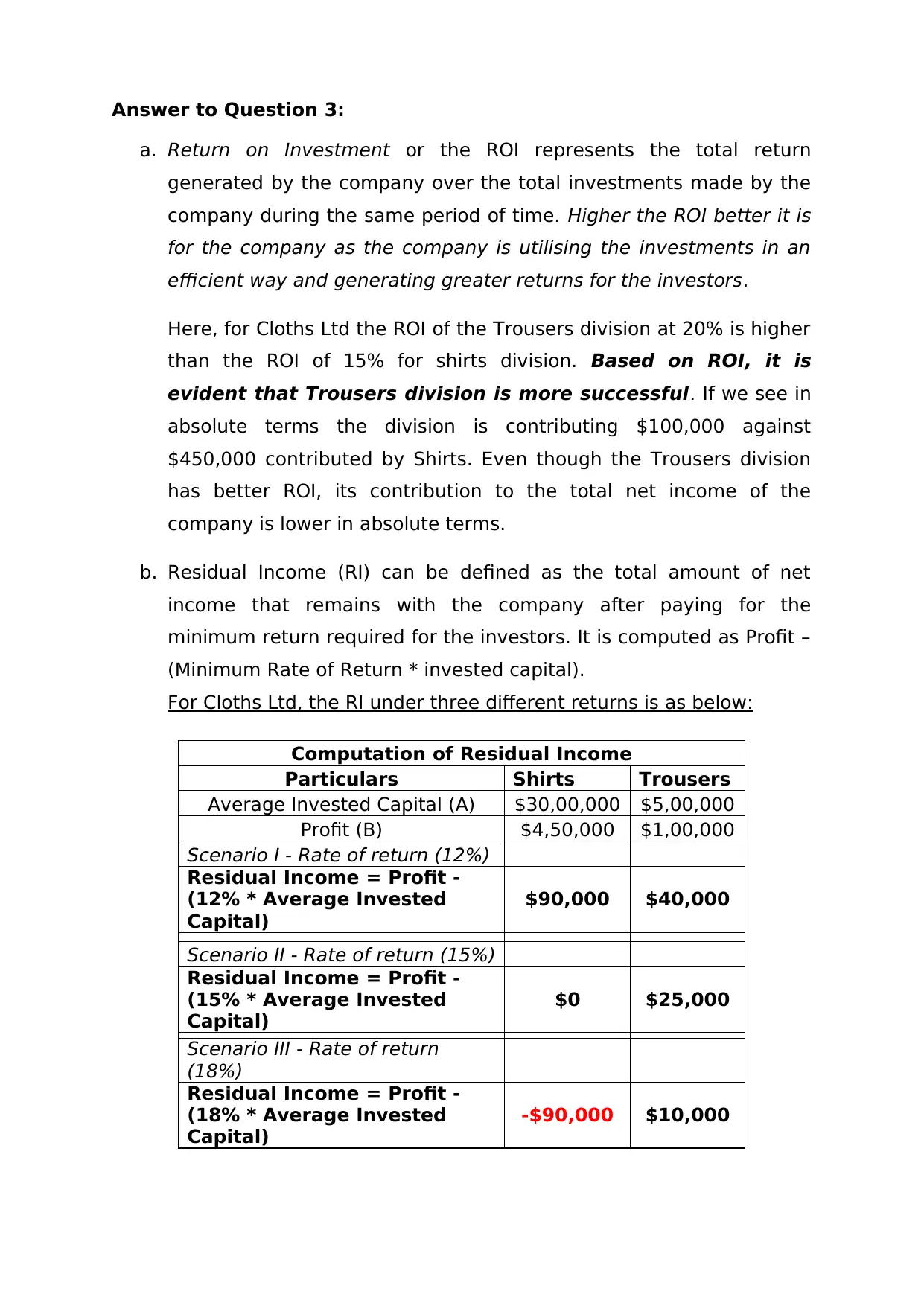
Answer to Question 3:
a. Return on Investment or the ROI represents the total return
generated by the company over the total investments made by the
company during the same period of time. Higher the ROI better it is
for the company as the company is utilising the investments in an
efficient way and generating greater returns for the investors.
Here, for Cloths Ltd the ROI of the Trousers division at 20% is higher
than the ROI of 15% for shirts division. Based on ROI, it is
evident that Trousers division is more successful. If we see in
absolute terms the division is contributing $100,000 against
$450,000 contributed by Shirts. Even though the Trousers division
has better ROI, its contribution to the total net income of the
company is lower in absolute terms.
b. Residual Income (RI) can be defined as the total amount of net
income that remains with the company after paying for the
minimum return required for the investors. It is computed as Profit –
(Minimum Rate of Return * invested capital).
For Cloths Ltd, the RI under three different returns is as below:
Computation of Residual Income
Particulars Shirts Trousers
Average Invested Capital (A) $30,00,000 $5,00,000
Profit (B) $4,50,000 $1,00,000
Scenario I - Rate of return (12%)
Residual Income = Profit -
(12% * Average Invested
Capital)
$90,000 $40,000
Scenario II - Rate of return (15%)
Residual Income = Profit -
(15% * Average Invested
Capital)
$0 $25,000
Scenario III - Rate of return
(18%)
Residual Income = Profit -
(18% * Average Invested
Capital)
-$90,000 $10,000
a. Return on Investment or the ROI represents the total return
generated by the company over the total investments made by the
company during the same period of time. Higher the ROI better it is
for the company as the company is utilising the investments in an
efficient way and generating greater returns for the investors.
Here, for Cloths Ltd the ROI of the Trousers division at 20% is higher
than the ROI of 15% for shirts division. Based on ROI, it is
evident that Trousers division is more successful. If we see in
absolute terms the division is contributing $100,000 against
$450,000 contributed by Shirts. Even though the Trousers division
has better ROI, its contribution to the total net income of the
company is lower in absolute terms.
b. Residual Income (RI) can be defined as the total amount of net
income that remains with the company after paying for the
minimum return required for the investors. It is computed as Profit –
(Minimum Rate of Return * invested capital).
For Cloths Ltd, the RI under three different returns is as below:
Computation of Residual Income
Particulars Shirts Trousers
Average Invested Capital (A) $30,00,000 $5,00,000
Profit (B) $4,50,000 $1,00,000
Scenario I - Rate of return (12%)
Residual Income = Profit -
(12% * Average Invested
Capital)
$90,000 $40,000
Scenario II - Rate of return (15%)
Residual Income = Profit -
(15% * Average Invested
Capital)
$0 $25,000
Scenario III - Rate of return
(18%)
Residual Income = Profit -
(18% * Average Invested
Capital)
-$90,000 $10,000
Paraphrase This Document
Need a fresh take? Get an instant paraphrase of this document with our AI Paraphraser
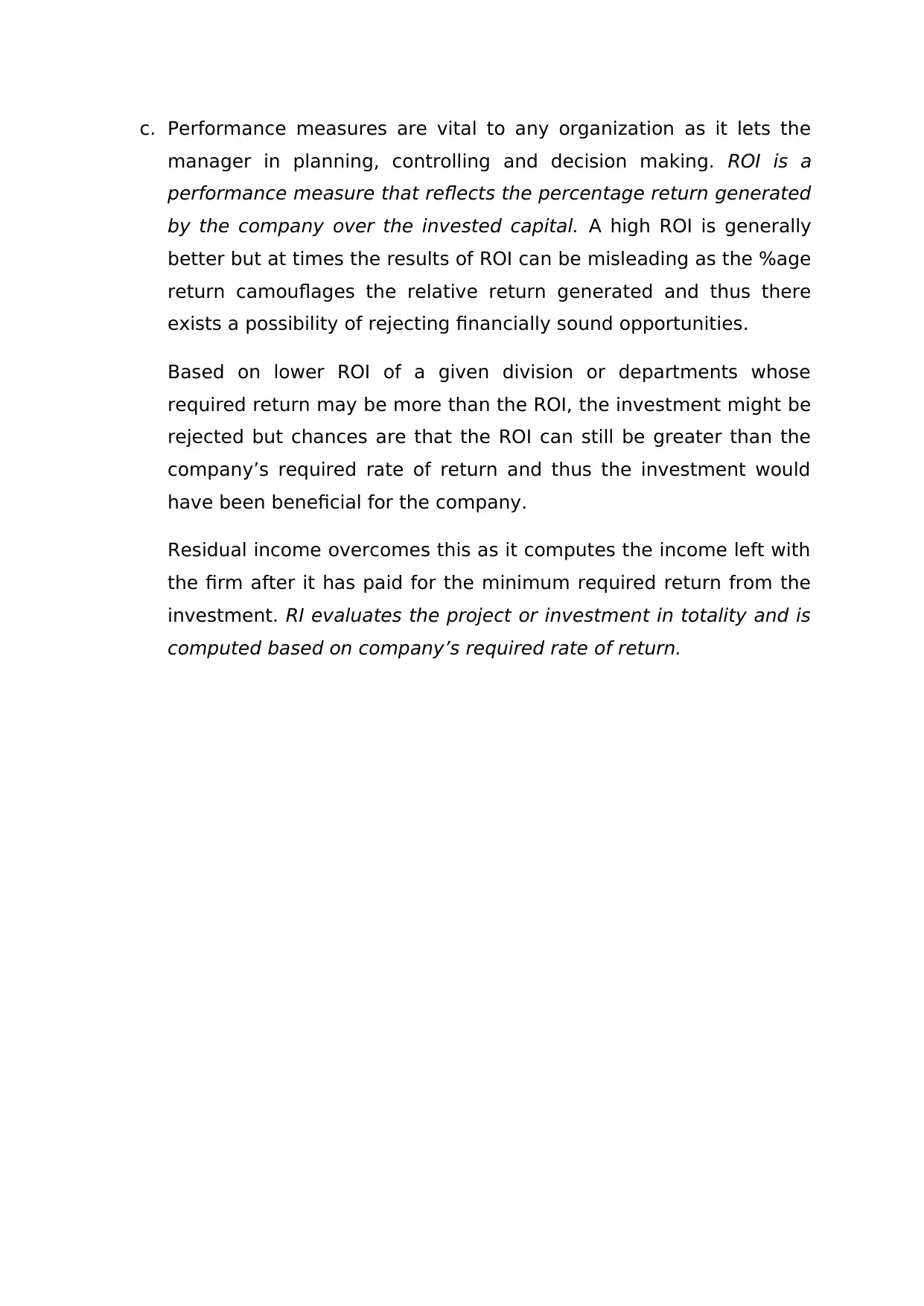
c. Performance measures are vital to any organization as it lets the
manager in planning, controlling and decision making. ROI is a
performance measure that reflects the percentage return generated
by the company over the invested capital. A high ROI is generally
better but at times the results of ROI can be misleading as the %age
return camouflages the relative return generated and thus there
exists a possibility of rejecting financially sound opportunities.
Based on lower ROI of a given division or departments whose
required return may be more than the ROI, the investment might be
rejected but chances are that the ROI can still be greater than the
company’s required rate of return and thus the investment would
have been beneficial for the company.
Residual income overcomes this as it computes the income left with
the firm after it has paid for the minimum required return from the
investment. RI evaluates the project or investment in totality and is
computed based on company’s required rate of return.
manager in planning, controlling and decision making. ROI is a
performance measure that reflects the percentage return generated
by the company over the invested capital. A high ROI is generally
better but at times the results of ROI can be misleading as the %age
return camouflages the relative return generated and thus there
exists a possibility of rejecting financially sound opportunities.
Based on lower ROI of a given division or departments whose
required return may be more than the ROI, the investment might be
rejected but chances are that the ROI can still be greater than the
company’s required rate of return and thus the investment would
have been beneficial for the company.
Residual income overcomes this as it computes the income left with
the firm after it has paid for the minimum required return from the
investment. RI evaluates the project or investment in totality and is
computed based on company’s required rate of return.
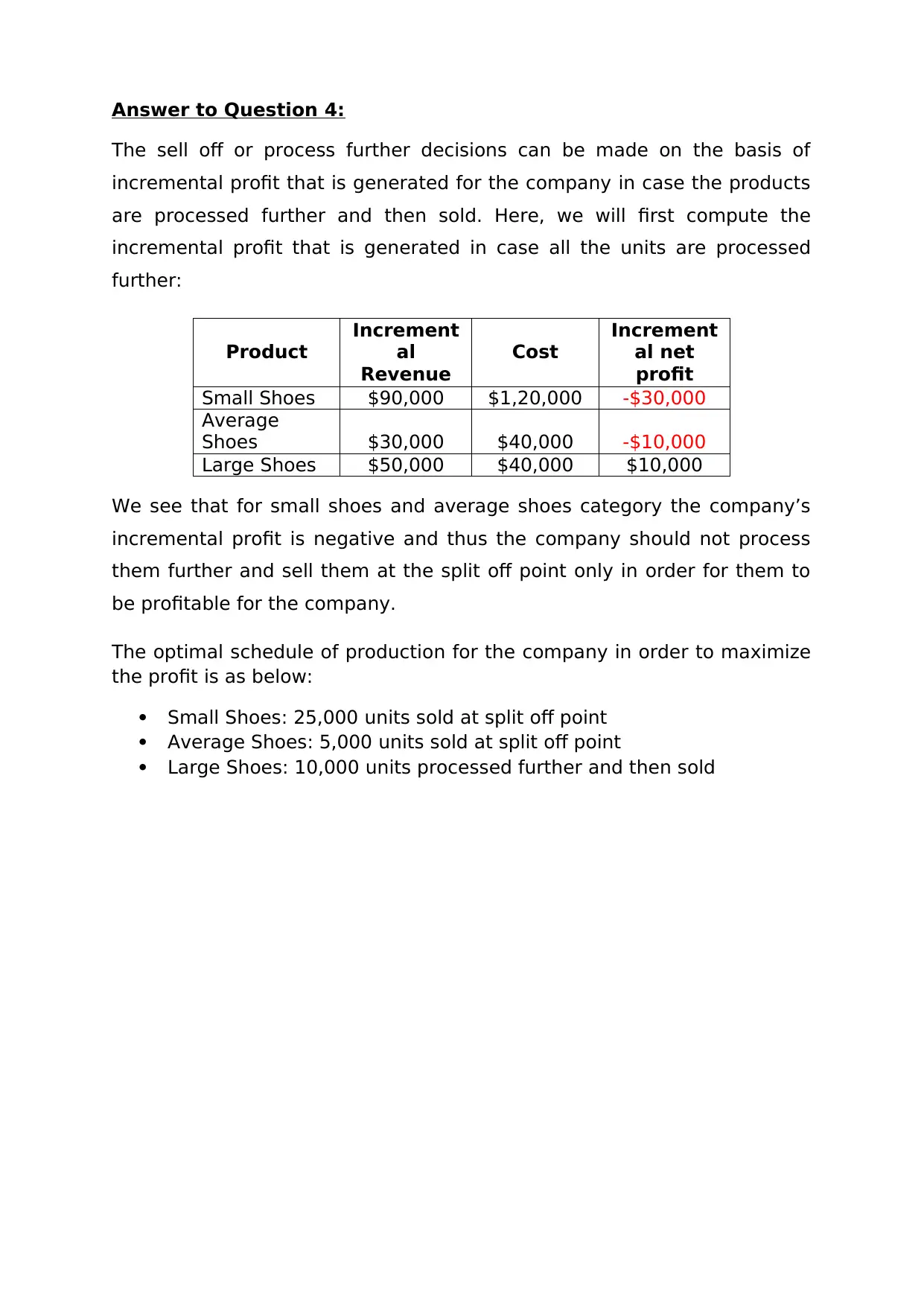
Answer to Question 4:
The sell off or process further decisions can be made on the basis of
incremental profit that is generated for the company in case the products
are processed further and then sold. Here, we will first compute the
incremental profit that is generated in case all the units are processed
further:
Product
Increment
al
Revenue
Cost
Increment
al net
profit
Small Shoes $90,000 $1,20,000 -$30,000
Average
Shoes $30,000 $40,000 -$10,000
Large Shoes $50,000 $40,000 $10,000
We see that for small shoes and average shoes category the company’s
incremental profit is negative and thus the company should not process
them further and sell them at the split off point only in order for them to
be profitable for the company.
The optimal schedule of production for the company in order to maximize
the profit is as below:
Small Shoes: 25,000 units sold at split off point
Average Shoes: 5,000 units sold at split off point
Large Shoes: 10,000 units processed further and then sold
The sell off or process further decisions can be made on the basis of
incremental profit that is generated for the company in case the products
are processed further and then sold. Here, we will first compute the
incremental profit that is generated in case all the units are processed
further:
Product
Increment
al
Revenue
Cost
Increment
al net
profit
Small Shoes $90,000 $1,20,000 -$30,000
Average
Shoes $30,000 $40,000 -$10,000
Large Shoes $50,000 $40,000 $10,000
We see that for small shoes and average shoes category the company’s
incremental profit is negative and thus the company should not process
them further and sell them at the split off point only in order for them to
be profitable for the company.
The optimal schedule of production for the company in order to maximize
the profit is as below:
Small Shoes: 25,000 units sold at split off point
Average Shoes: 5,000 units sold at split off point
Large Shoes: 10,000 units processed further and then sold
⊘ This is a preview!⊘
Do you want full access?
Subscribe today to unlock all pages.

Trusted by 1+ million students worldwide
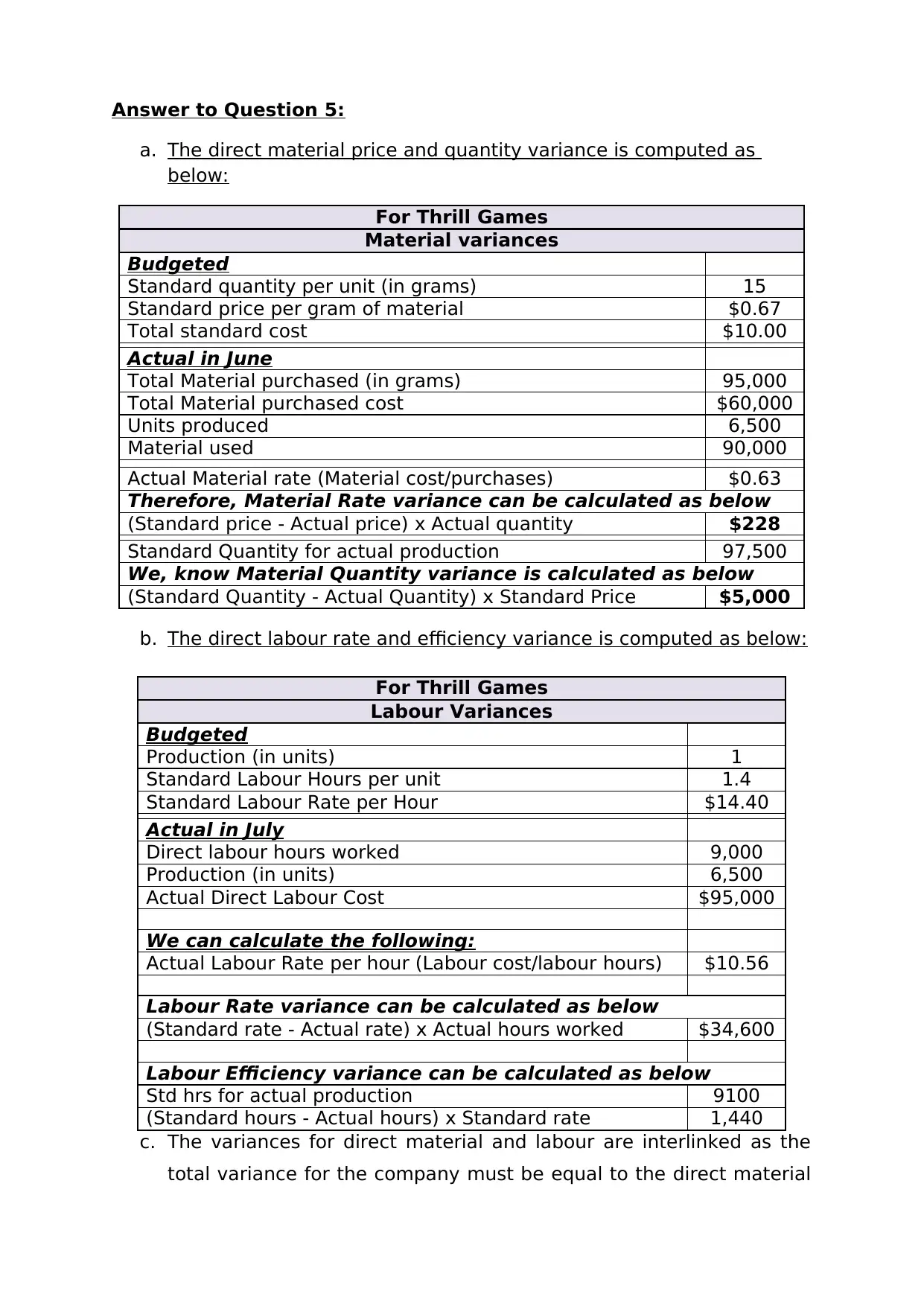
Answer to Question 5:
a. The direct material price and quantity variance is computed as
below:
For Thrill Games
Material variances
Budgeted
Standard quantity per unit (in grams) 15
Standard price per gram of material $0.67
Total standard cost $10.00
Actual in June
Total Material purchased (in grams) 95,000
Total Material purchased cost $60,000
Units produced 6,500
Material used 90,000
Actual Material rate (Material cost/purchases) $0.63
Therefore, Material Rate variance can be calculated as below
(Standard price - Actual price) x Actual quantity $228
Standard Quantity for actual production 97,500
We, know Material Quantity variance is calculated as below
(Standard Quantity - Actual Quantity) x Standard Price $5,000
b. The direct labour rate and efficiency variance is computed as below:
For Thrill Games
Labour Variances
Budgeted
Production (in units) 1
Standard Labour Hours per unit 1.4
Standard Labour Rate per Hour $14.40
Actual in July
Direct labour hours worked 9,000
Production (in units) 6,500
Actual Direct Labour Cost $95,000
We can calculate the following:
Actual Labour Rate per hour (Labour cost/labour hours) $10.56
Labour Rate variance can be calculated as below
(Standard rate - Actual rate) x Actual hours worked $34,600
Labour Efficiency variance can be calculated as below
Std hrs for actual production 9100
(Standard hours - Actual hours) x Standard rate 1,440
c. The variances for direct material and labour are interlinked as the
total variance for the company must be equal to the direct material
a. The direct material price and quantity variance is computed as
below:
For Thrill Games
Material variances
Budgeted
Standard quantity per unit (in grams) 15
Standard price per gram of material $0.67
Total standard cost $10.00
Actual in June
Total Material purchased (in grams) 95,000
Total Material purchased cost $60,000
Units produced 6,500
Material used 90,000
Actual Material rate (Material cost/purchases) $0.63
Therefore, Material Rate variance can be calculated as below
(Standard price - Actual price) x Actual quantity $228
Standard Quantity for actual production 97,500
We, know Material Quantity variance is calculated as below
(Standard Quantity - Actual Quantity) x Standard Price $5,000
b. The direct labour rate and efficiency variance is computed as below:
For Thrill Games
Labour Variances
Budgeted
Production (in units) 1
Standard Labour Hours per unit 1.4
Standard Labour Rate per Hour $14.40
Actual in July
Direct labour hours worked 9,000
Production (in units) 6,500
Actual Direct Labour Cost $95,000
We can calculate the following:
Actual Labour Rate per hour (Labour cost/labour hours) $10.56
Labour Rate variance can be calculated as below
(Standard rate - Actual rate) x Actual hours worked $34,600
Labour Efficiency variance can be calculated as below
Std hrs for actual production 9100
(Standard hours - Actual hours) x Standard rate 1,440
c. The variances for direct material and labour are interlinked as the
total variance for the company must be equal to the direct material
Paraphrase This Document
Need a fresh take? Get an instant paraphrase of this document with our AI Paraphraser
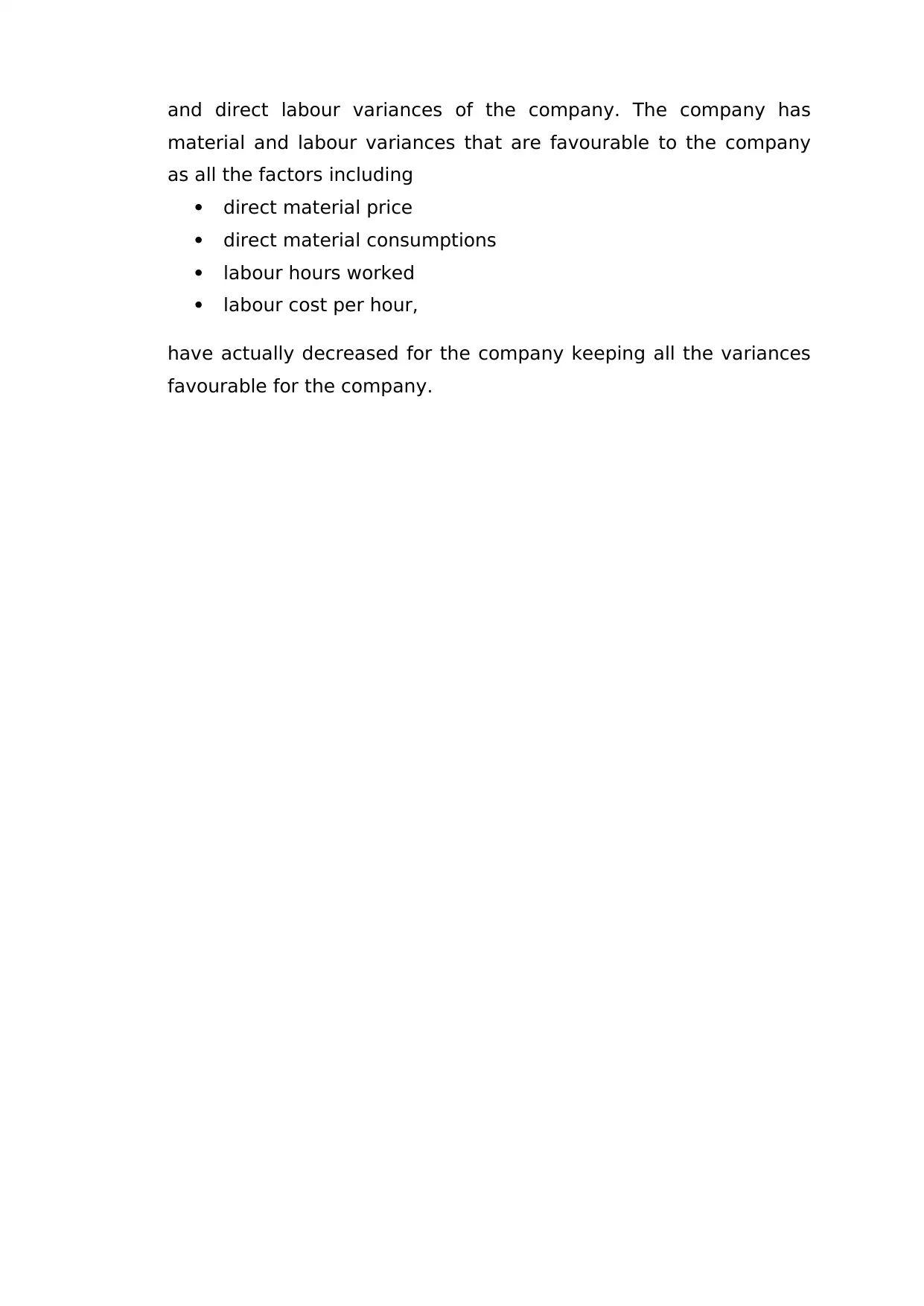
and direct labour variances of the company. The company has
material and labour variances that are favourable to the company
as all the factors including
direct material price
direct material consumptions
labour hours worked
labour cost per hour,
have actually decreased for the company keeping all the variances
favourable for the company.
material and labour variances that are favourable to the company
as all the factors including
direct material price
direct material consumptions
labour hours worked
labour cost per hour,
have actually decreased for the company keeping all the variances
favourable for the company.
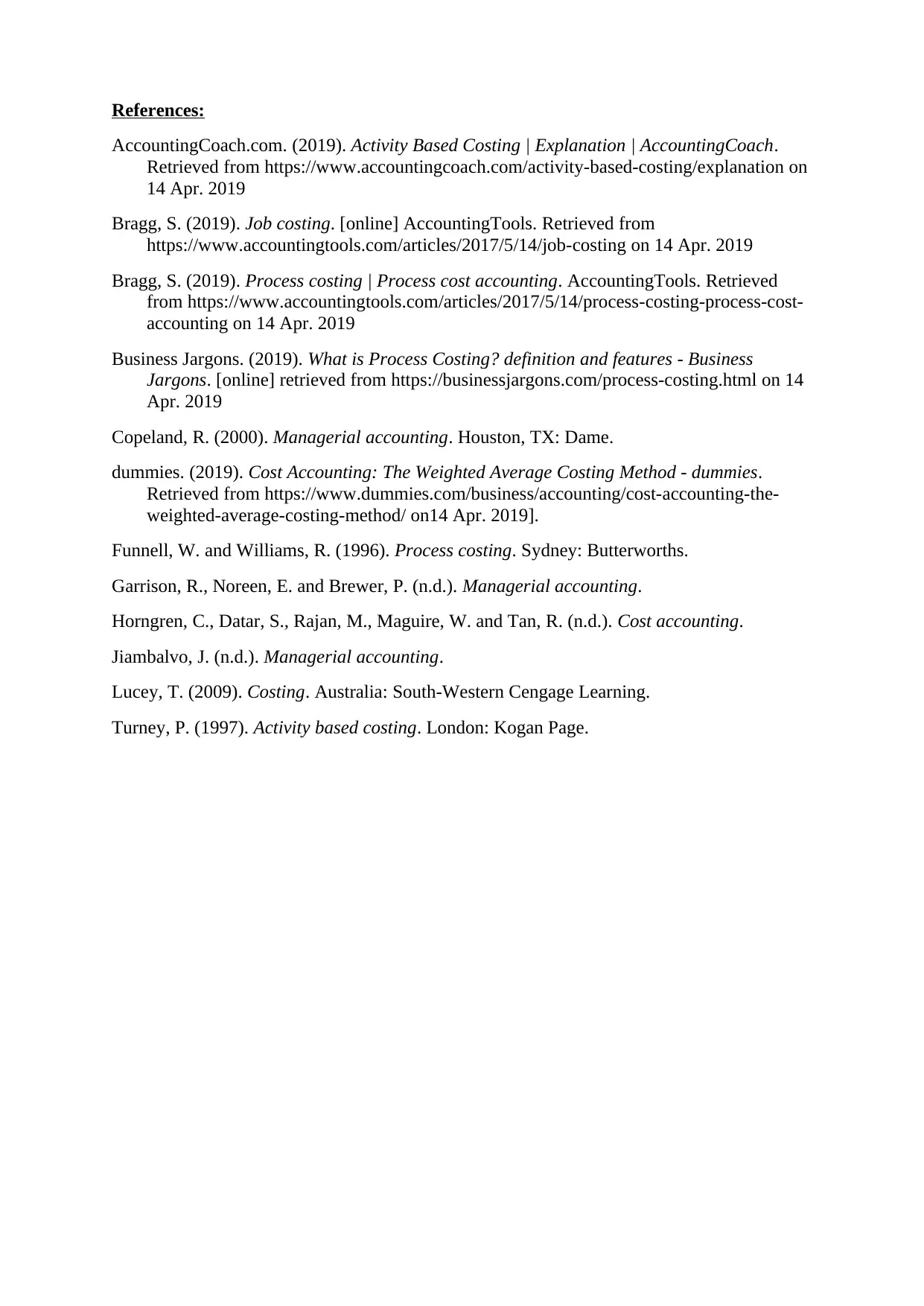
References:
AccountingCoach.com. (2019). Activity Based Costing | Explanation | AccountingCoach.
Retrieved from https://www.accountingcoach.com/activity-based-costing/explanation on
14 Apr. 2019
Bragg, S. (2019). Job costing. [online] AccountingTools. Retrieved from
https://www.accountingtools.com/articles/2017/5/14/job-costing on 14 Apr. 2019
Bragg, S. (2019). Process costing | Process cost accounting. AccountingTools. Retrieved
from https://www.accountingtools.com/articles/2017/5/14/process-costing-process-cost-
accounting on 14 Apr. 2019
Business Jargons. (2019). What is Process Costing? definition and features - Business
Jargons. [online] retrieved from https://businessjargons.com/process-costing.html on 14
Apr. 2019
Copeland, R. (2000). Managerial accounting. Houston, TX: Dame.
dummies. (2019). Cost Accounting: The Weighted Average Costing Method - dummies.
Retrieved from https://www.dummies.com/business/accounting/cost-accounting-the-
weighted-average-costing-method/ on14 Apr. 2019].
Funnell, W. and Williams, R. (1996). Process costing. Sydney: Butterworths.
Garrison, R., Noreen, E. and Brewer, P. (n.d.). Managerial accounting.
Horngren, C., Datar, S., Rajan, M., Maguire, W. and Tan, R. (n.d.). Cost accounting.
Jiambalvo, J. (n.d.). Managerial accounting.
Lucey, T. (2009). Costing. Australia: South-Western Cengage Learning.
Turney, P. (1997). Activity based costing. London: Kogan Page.
AccountingCoach.com. (2019). Activity Based Costing | Explanation | AccountingCoach.
Retrieved from https://www.accountingcoach.com/activity-based-costing/explanation on
14 Apr. 2019
Bragg, S. (2019). Job costing. [online] AccountingTools. Retrieved from
https://www.accountingtools.com/articles/2017/5/14/job-costing on 14 Apr. 2019
Bragg, S. (2019). Process costing | Process cost accounting. AccountingTools. Retrieved
from https://www.accountingtools.com/articles/2017/5/14/process-costing-process-cost-
accounting on 14 Apr. 2019
Business Jargons. (2019). What is Process Costing? definition and features - Business
Jargons. [online] retrieved from https://businessjargons.com/process-costing.html on 14
Apr. 2019
Copeland, R. (2000). Managerial accounting. Houston, TX: Dame.
dummies. (2019). Cost Accounting: The Weighted Average Costing Method - dummies.
Retrieved from https://www.dummies.com/business/accounting/cost-accounting-the-
weighted-average-costing-method/ on14 Apr. 2019].
Funnell, W. and Williams, R. (1996). Process costing. Sydney: Butterworths.
Garrison, R., Noreen, E. and Brewer, P. (n.d.). Managerial accounting.
Horngren, C., Datar, S., Rajan, M., Maguire, W. and Tan, R. (n.d.). Cost accounting.
Jiambalvo, J. (n.d.). Managerial accounting.
Lucey, T. (2009). Costing. Australia: South-Western Cengage Learning.
Turney, P. (1997). Activity based costing. London: Kogan Page.
⊘ This is a preview!⊘
Do you want full access?
Subscribe today to unlock all pages.

Trusted by 1+ million students worldwide
1 out of 6
Related Documents
Your All-in-One AI-Powered Toolkit for Academic Success.
+13062052269
info@desklib.com
Available 24*7 on WhatsApp / Email
![[object Object]](/_next/static/media/star-bottom.7253800d.svg)
Unlock your academic potential
Copyright © 2020–2025 A2Z Services. All Rights Reserved. Developed and managed by ZUCOL.





